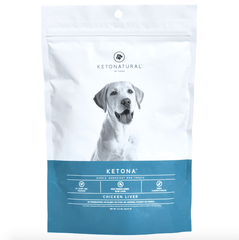Save Money, Save Your Dog.
Join Our Email List For Discounted Pricing and a Free Guide to the Science of Keto Dog Food.
"Summertime and the livin’s easy.”
Summer is a great time to be a dog owner, there’s no doubt about it. Winter’s dreary mornings and frosty evenings are things of the past. Now the days are long, the sun is shining, and the grass is green--the conditions are perfect for getting outside and being active with your pup.
Or are they?
Well, it’s complicated. On the one hand, if the warmer weather makes you want to get off the couch and go outside to play with your dog, then we’re never going to argue that the steamy temps are all bad. Developing an active lifestyle is by far the most important step in creating lifelong fitness for both you and your pet. So if warm, sunny weather is what it takes to get you outside, then bring on the heat!
That being said, there are some things every dog owner needs to understand before asking his or her dog to exert itself in the heat. A failure to appreciate these important concepts could have frightening health consequences for both you and your pooch as the mercury rises. We’ll be discussing these concepts over the next few posts. Today we tackle the heat dissipation process known as thermoregulation. Through a proper understanding of this biological process, we’ll be able to develop exercise and nutrition strategies that maximize thermoregulatory efficiency and avoid the dangerous consequences of high-temp exercise.
Thermoregulation is the biological process by which animal organisms keep their core body temperatures between certain boundaries, even when temperatures in the surrounding environment fluctuate beyond those boundaries. You see, animals bodies tend to heat up when exposed to a hot environment. This isn’t good for the bodies; prolonged or severe increases to core temperature can result in dangerous health conditions such as dehydration and heat stroke. Being warm-blooded, mammals are equipped with systems which help them to cool their bodies and avoid these conditions. But if the cooling systems can’t keep up with rising external temperatures, then core temperatures rise too. This is bad.
Humans primarily cool themselves through their skin. They perspire, and as the sweat evaporates it cools the skin. But unlike humans (and other large mammals such as horses), dogs don’t produce sweat for thermoregulation purposes. In fact, the only places on a dog’s body where sweat glands secrete any meaningful amount of fluid are their paw pads, from which eccrine glands secrete a small amount of fluid for purposes other than heat dissipation.
Instead, a dog’s primary method of thermoregulation is evaporative cooling from the tongue and respiratory tract through the process known as panting. Essentially, the dog secretes saliva, which quickly evaporates as air passes over it (as both inhalation and exhalation). That warmed air is eventually exhaled from the dog’s body, lowering the body’s temperature.
In order for this process to function efficiently, two notable things have happen. First, the tongue actually increases in surface area (to as much as six times its normal size!). Second, the respiratory rate increases dramatically (to as much as ten times the normal resting rate!) and shallows. The net impact of these two changes is an increase in respiratory airflow and an increase in salivatory evaporation from the tongue. This causes heat to rapidly dissipate from the dog’s body. (You can experience this yourself: try taking very shallow, rapid--more than 60 per minute--breaths for a little while and you’ll start to feel a cooling sensation in your mouth and upper esophagus.)
With this fundamental outline of the panting process in mind, there are at least three additional phenomena that must be understood in order to fully appreciate the importance of thermoregulation to warm weather canine exercise. First of all, while an accelerated respiratory rate is a necessary component of effective panting, mammals such as dogs generally exhibit a 1:1 stride to breathing frequency ratio during galloping. This means that a galloping dog simply cannot and will not breath quickly enough to pant effectively. If he gallops for more than a few minutes in warm weather, he will overheat. And quickly.
Second, dogs with shortened muzzles have shorter tongues, nasal passages, and upper respiratory pathways, thus ensuring less efficient salivatory evaporation. So breeds like bulldogs, Boston terriers, and boxers should not be expected to pant as effectively as long-muzzled pointers and retrievers.
Lastly, body mass and coat play important roles in canine thermoregulation. In short, all else being equal, a dog with a heavier coat will heat up more quickly than one with a light coat and a heavier dog will heat up more quickly than a light-weight dog.
That’s surely more than enough information about this somewhat obscure topic. Thanks for reading. Let’s hear your questions about canine thermoregulation, Team! In Part 2, we apply some of these concepts and develop a hydration strategy.


Related Articles
How Much Does The Farmer’s Dog Really Cost?
5 Signs and Symptoms That Your Dog May Have Diabetes
Learning to Take Pleasure In Being Your Dog's Play Buddy-Drill Sargeant
Dogs, Dog Food and Dogma - A Book About America's Pet Obesity Epidemic
Browse Articles By Category